Learn how to cook frozen shrimp in a skillet on the stove-top. It really is possible to get perfectly seared shrimp even when shrimp have been frozen.
I'll share my number one secret that works each and every time.
Have you ever tried getting that perfect sear on your shrimp and have failed? Or, have you wondered why you can't seem to get that beautiful brown coating on your shrimp that you see in restaurants or some recipe sites? Instead, you're stuck with pink rubbery shrimp. If so, I've been there.
Jump to:
- How to thaw frozen shrimp before cooking?
- Technique for drying (secret to perfect sear)
- Why this method works
- Searing shrimp
- Other cooking methods
- Flavor variations
- Expert tips
- Common mistakes to avoid when cooking frozen shrimp
- Store and Reheat
- FAQs
- Other seafood recipes, you'll love
- Did you make this recipe?
- 📖 Recipe
How to thaw frozen shrimp before cooking?
No matter which cooking method you're using for a particular recipe, shrimp must be thawed first in order to remove the digestive tract that runs alongside the top and under belly of the shrimp and that is a MUST.
When defrosting shrimp, you have 2 options:
- Place the frozen shrimp in the refrigerator to thaw. The shrimp will begin to thaw gradually which can take several hours. If you're planning to have shrimp for dinner that evening, place the shrimp in the fridge the morning of or overnight if you're having the following day.
- Remove the frozen shrimp from its bag, and add them to a big bowl of cold water making sure they are submerged in the water. The shrimp will thaw gradually and ice crystals will form. This may take up to 20 minute or so.
If you choose the 2nd option to defrost shrimp, empty the water from the bowl after about 20 minutes and run water over the shrimp to remove any ice crystals that you see then drain the water from the bowl.
Technique for drying (secret to perfect sear)
After the shrimp is thawed and have been thoroughly cleaned, line a baking sheet with layers of paper towels and place the thawed shrimp on the baking sheet in a single layer. This method will allow the paper towels to absorb any moisture from the shrimp.
In addition, use a paper towel to pat dry the top of the shrimp to absorb any remaining moisture.
With that said, do not ever put frozen shrimp in the microwave to thawed. Doing so can potentially change the texture of the shrimp.
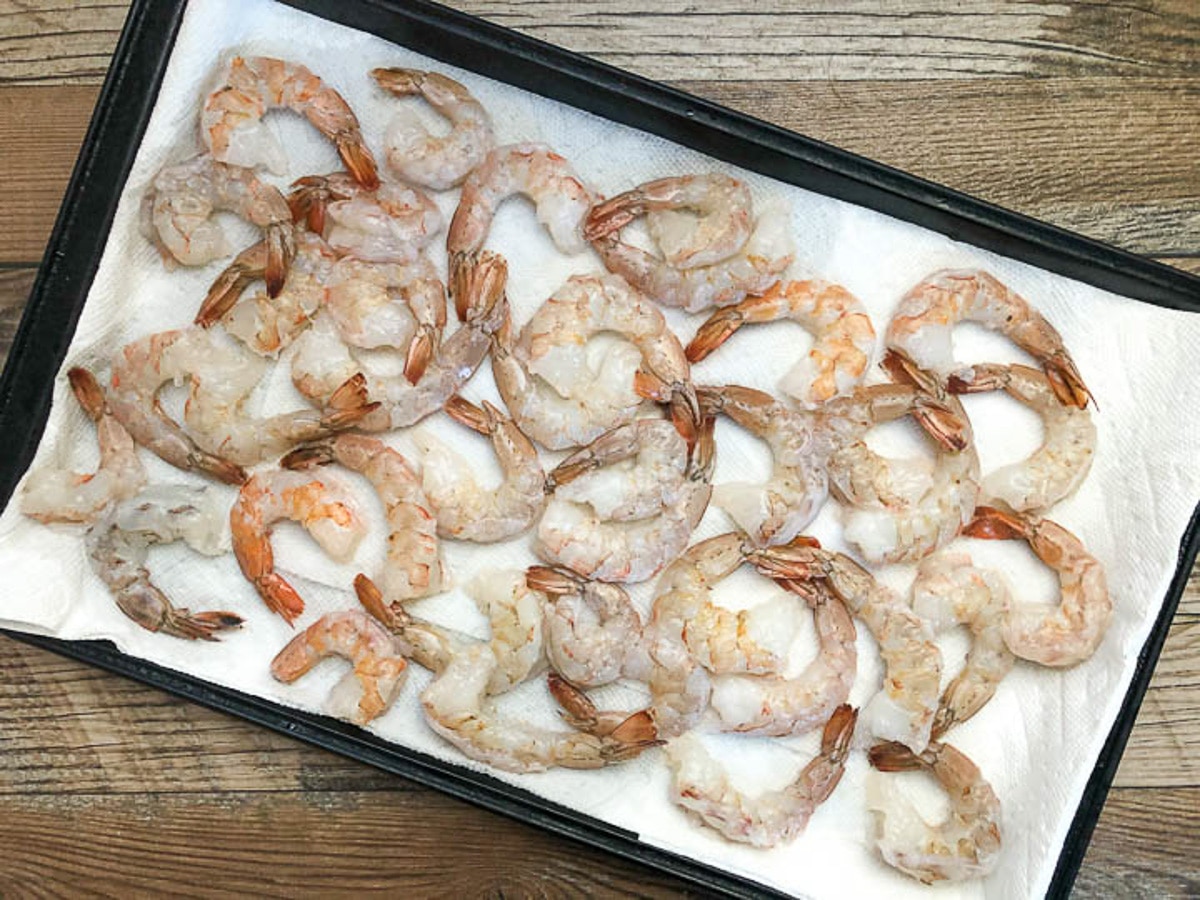
Why this method works
I tried everything until it dawned on me that shrimp should be treated similar to other meat that requires a sear if you're going for that beautiful golden brown crispy outer coating.
Instead of using a paper towel to pat-dry as you would before searing meat, place the shrimp on top of layers of paper towels to dry after cleaning them, and that my friends is the secret.
By doing this one thing, was a complete game-changer and is why this method on how to cook frozen shrimp works especially when you're aiming for that perfect sear or crunchy outer coating when frying.
Searing shrimp
Searing shrimp is one of the quickest and most flavorful ways to prepare this versatile seafood. With just a hot pan, a little oil, and a few minutes, you can achieve a beautiful golden-brown crust that locks in the shrimp’s natural juices and enhances its sweet, delicate flavor. Let’s get into it:
- After the frozen shrimp have been thawed, cleaned, and thoroughly dried, season with kosher salt, black pepper, and Cajun seasoning.
- Add oil and a little butter to a skillet over medium high heat and once the oil is hot, swirl the oil around to cover the bottom of the skillet.
- Add the seasoned shrimp to the skillet in a single layer without crowding the pan and sear for 2 to 3 minutes on one side, flip and sear the other side for 2 minutes then turn off the heat.
- Quickly spoon the oil butter mixture over the shrimp and add freshly squeezed lemon juice, transfer shrimp to a serving bowl or platter and garnish with cilantro or parsley.
- Serve over rice, pasta, noodles, salad, or make tacos, burritos, enchiladas, shrimp bowls, vegetable dishes or add to a stir fry.
Other cooking methods
While searing is a popular method for its quick cook time and rich caramelization, there are other techniques that give you delicious results.
Deep fry or panko fried
Frying larger shrimp should not take longer than 6 minutes to cook; however, smaller sized shrimp will require a shorter cook time. Try these crispy golden brown Easy Cajun Panko Fried Shrimp recipe along with these Fried Shrimp Tacos with Avocado Crema for the perfect taco Tuesday.
Boiling
Boiling isn't my ideal way to cook shrimp as it tends to lack flavor unless you're making this incredible Cajun Seafood Boil or this Easy Seafood Gumbo Recipe. This method still requires that the frozen shrimp be thawed first in order to de-veined and cleaned, but you can skip the drying technique described above.
Grilling
Grilling adds a depth of flavor to the shrimp especially when charcoal grilled and cooks for about 2 to 3 minutes per side depending on the size of the shrimp. Ideally, use skewers when grilling shrimp as it makes this method of cooking easier and prevents them from falling through the grates.
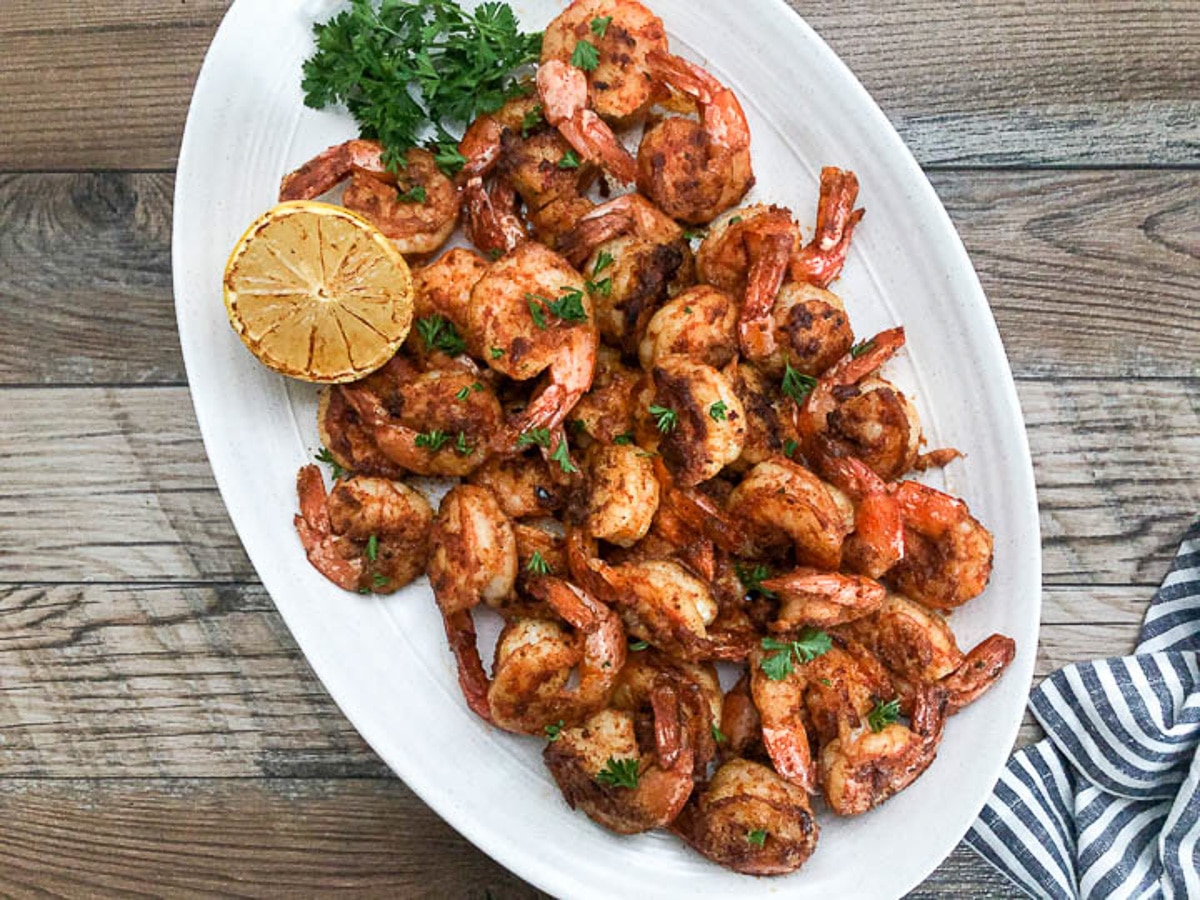
Flavor variations
When it comes to cooking shrimp the possibilities are endless. Whether you prefer something light and lemony like this White Wine Lemon Garlic Shrimp Pasta, or bold with a little kick give this Creamy Cajun Shrimp Pasta (without Cream) a try. Or, if you're craving rich and creamy without the added calories of heavy cream this Shrimp and Asparagus Pasta is for you.
Experimenting with different flavor combinations can take your shrimp from simple to amazing.
Expert tips
- Always de-vein shrimp even when the packaging indicates already de-veined it doesn't hurt to go through the shrimp to make sure they're clean even if the recipe calls for the shrimp to be boiled.
- For perfectly seared shrimp, make sure they're completely dry before adding them to the skillet (follow the method I described above by using layers of paper towels).
- Frozen raw shrimp are the freshest and should be used instead of defrosted shrimp that's at the seafood counter of your local grocery store.
- For perfectly golden brown shrimp, sear the shrimp in batches to prevent the shrimp from steaming.
Common mistakes to avoid when cooking frozen shrimp
- Shrimp cook fast, so be sure to remove them from heat as soon as they’re pink and opaque to avoid toughness.
- Overcrowding the pan when sautéing or searing can steam the shrimp instead of giving them a nice sear.
- Before cooking, pat the shrimp dry with a paper towel to remove excess moisture. This helps them develop better flavor.
Store and Reheat
Storing
Place cooked shrimp in an airtight container with a tight-fitting lid and refrigerate for up to 2 days.
Reheating
To reheat, warm the shrimp gently in a skillet over low heat just until warm throughout. Be careful not to overcook them.
FAQs
Yes, you should defrost shrimp before cooking for a few reasons and here's why: 1) Shrimp must be de-veined and cleaned; 2) If you want perfectly seared shrimp; 3) To prevent the shrimp from releasing extra water or ice crystals into the recipe; 4) Allows the seasonings to adhere to the shrimp better which makes the shrimp more flavorful and doesn't make the recipe taste watered-down.
Whether you're searing, baking, sauteing, broiling, roasting, boiling, or grilling shrimp after they have thawed, they cook really fast.
They only take a few minutes to cook depending on the size and the cooking method. If they're cooked too long, they can become dry and tough. With that said, transfer them to a serving bowl or platter to prevent the residual heat from the skillet from cooking them further.
The process for cleaning shrimp is quite simple. You'll need to: Remove the outer shell and discard; 2) Remove the tail or leave it in tact (I typically leave it intact for presentation purposes depending on the recipe; 3) Use a paring knife or steak knife to cut a slit along the under-belly lengthwise and along the back lengthwise to remove the digestive tract; 4) Rinse under cold water.
Perfectly cooked shrimp will turn from translucent to opaque pink in color. As they cook, they will form into a nice loose "C" shape; however, if they form into a tight "O" shape this is an indication that they're overcooked.
For a sure-fire way to tell if shrimp are cooked properly, use a meat thermometer to check the internal temperature. This is done by inserting the meat thermometer into the thickest part of the shrimp. When the temperature reaches 140 degrees F, they're done.
Other seafood recipes, you'll love
Did you make this recipe?
If so, let me know how it went. Leave a 'Star Rating' within the recipe card down below and/or TAG @cookingwithbliss on Instagram. I can't wait to see how it turned out.
📖 Recipe
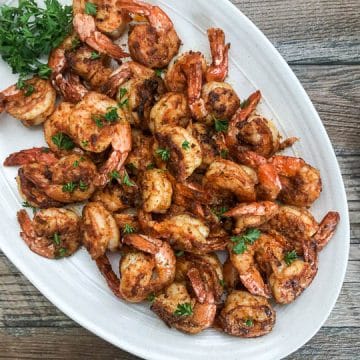
How to Cook Frozen Shrimp
How to Cook Frozen ShrimpEquipment
- Skillet or cast iron skillet
- Bowl for thawing shrimp
- Instant meat thermometer
Ingredients
- 2 lbs frozen raw shrimp
- 2 teaspoon kosher salt
- 1 teaspoon black pepper
- 1-2 tablespoon Cajun seasoning
- 2 tablespoon grape-seed oil (or olive oil)
- 2 tablespoon fresh lemon juice (from lemon)
- parsley (for garnish)
Instructions
- Layer paper towels on baking sheet. Set aside.
- Place frozen shrimp in a bowl of cold water and allow to thaw for 20 minutes or so. Drain water from the bowl then run cold water over the shrimp to get rid of any ice crystals that may have formed.
- Use a paring knife or steak knife to gently cut a slit lengthwise on the underbelly and the backside of the shrimp to remove the digestive tract. Discard the digestive tract. Rinse the shrimp really well.
- Place the shrimp in a single layer on the prepared baking sheet to absorb all of the moisture from the shrimp. Use a couple of additional paper towels to pat dry the surface of the shrimp.
- Place the shrimp in a large bowl and season with kosher salt, black pepper and Cajun seasoning and mix until all shrimp are coated.
- Add grape-seed oil or olive oil and butter to a skillet and place over medium high heat. Swirl the cooking oil around the pan. Place the shrimp in a single in the skillet and sear for 2 to 3 minutes. Flip the shrimp and sear for another 2 minutes. Turn off the heat.
- Remove shrimp from skillet and transfer to a serving bowl or platter. Do not keep the shrimp in the skillet as the residual heat will continue to cook the shrimp which can result in them becoming overcooked and rubbery.
Notes
- Always de-vein shrimp even when the packaging indicates already de-veined it doesn't hurt to go through the shrimp to make sure they're clean even if the recipe calls for the shrimp to be boiled.
- For perfectly seared shrimp, make sure they're completely dry before adding them to the skillet (follow the method I described above by using layers of paper towels).
- Frozen raw shrimp are the freshest and should be used instead of defrosted shrimp that's at the seafood counter of your local grocery store.
- For perfectly golden brown shrimp, sear the shrimp in batches to prevent the shrimp from steaming.
Nutrition
Nutrition Disclaimer
Nutritional information is an estimate provided by an online nutrition calculator. For the most accurate results, we recommend calculating the nutritional information using the specific ingredients and brands you use.


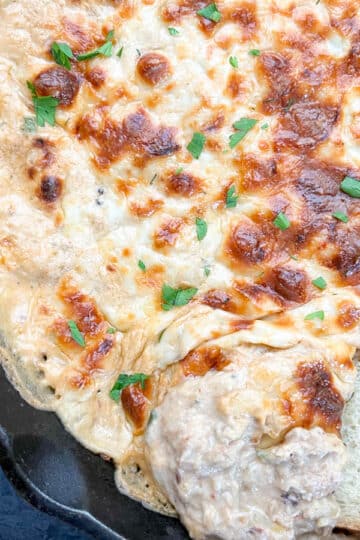
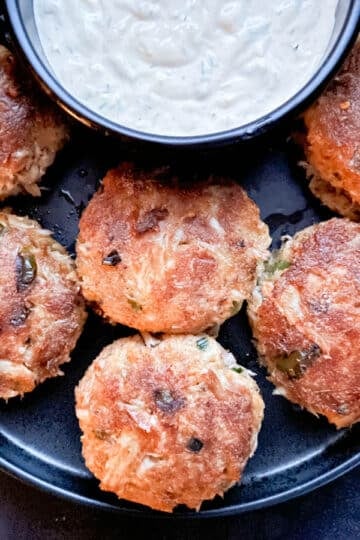
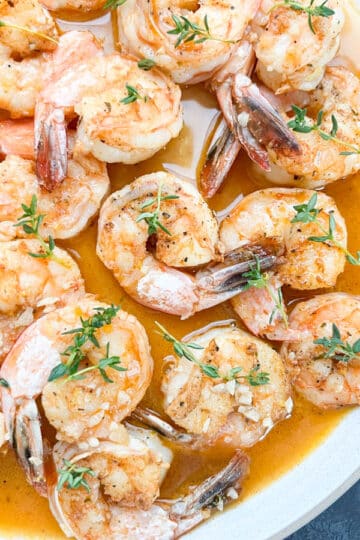
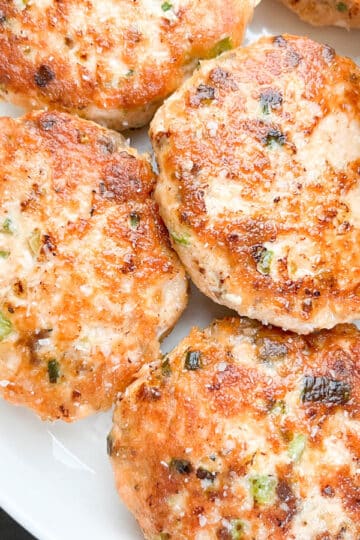
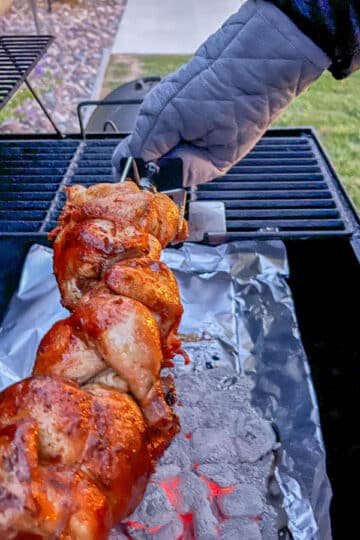
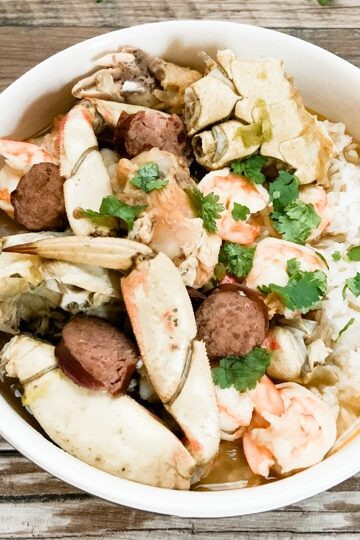
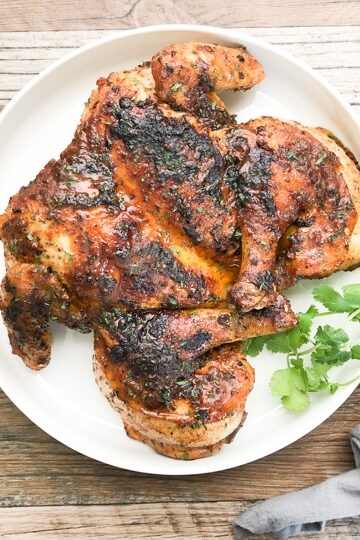

Thanks for visiting! Please feel free to leave a comment